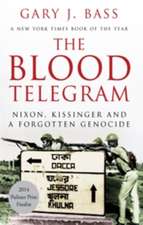The Temple of Jerusalem: Past, Present, and Future
Autor John M. Lundquisten Limba Engleză Hardback – 29 dec 2007 – vârsta până la 17 ani
Preț: 358.56 lei
Preț vechi: 435.96 lei
-18% Nou
Puncte Express: 538
Preț estimativ în valută:
68.62€ • 71.37$ • 56.65£
68.62€ • 71.37$ • 56.65£
Carte tipărită la comandă
Livrare economică 14-28 aprilie
Preluare comenzi: 021 569.72.76
Specificații
ISBN-13: 9780275983390
ISBN-10: 0275983390
Pagini: 320
Dimensiuni: 156 x 235 x 28 mm
Greutate: 0.64 kg
Editura: Bloomsbury Publishing
Colecția Praeger
Locul publicării:New York, United States
ISBN-10: 0275983390
Pagini: 320
Dimensiuni: 156 x 235 x 28 mm
Greutate: 0.64 kg
Editura: Bloomsbury Publishing
Colecția Praeger
Locul publicării:New York, United States
Notă biografică
John M. Lundquist is The Susan and Douglas Dillon Chief Librarian of the Asian and Middle Eastern Division, The Research Libraries-Humanities and Social Sciences Library, New York Public Library. He has written many books and has written pieces for the New York Times Travel section.
Recenzii
The book is strengthened by Lundquist's referencing of a wide variety of ancient primary sources, his placing of archaeology and meaning in clear historical context, and his presentation of the issues and conflicts surrounding the Temple as well as of its current political, secular, and religious meaning..A well-researched and carefully presented work; highly recommended for academic, seminary, and public libraries.
In this exhaustive and fascinating work, Lundquist, the chief librarian of the New York Public Library's Asian and Middle Eastern Division, discusses the Temple's history and meaning for Jews, Christians, and Muslims. The final chapters focus on the Temple as the crux of political-religious conflict, based on literal interpretations of the Bible and the Quran, and its place in apocalyptic ideas in Judaism, Christianity, and Islam. A good purchase for university and larger public libraries.
Readers who have great interest in the ancient Near East will probably gain the most from this book. As someone who is interested in this area of study, I found the book engaging and well researched.
In this exhaustive and fascinating work, Lundquist, the chief librarian of the New York Public Library's Asian and Middle Eastern Division, discusses the Temple's history and meaning for Jews, Christians, and Muslims. The final chapters focus on the Temple as the crux of political-religious conflict, based on literal interpretations of the Bible and the Quran, and its place in apocalyptic ideas in Judaism, Christianity, and Islam. A good purchase for university and larger public libraries.
Readers who have great interest in the ancient Near East will probably gain the most from this book. As someone who is interested in this area of study, I found the book engaging and well researched.













